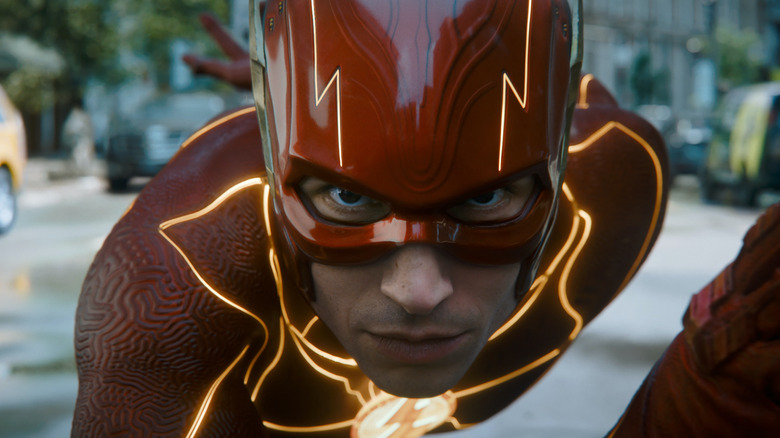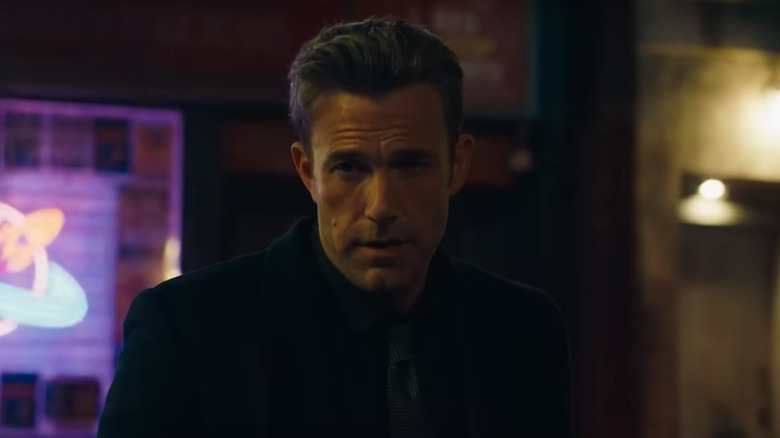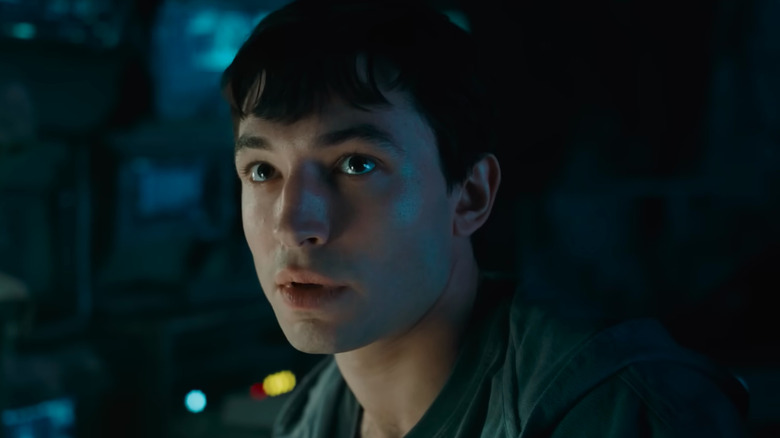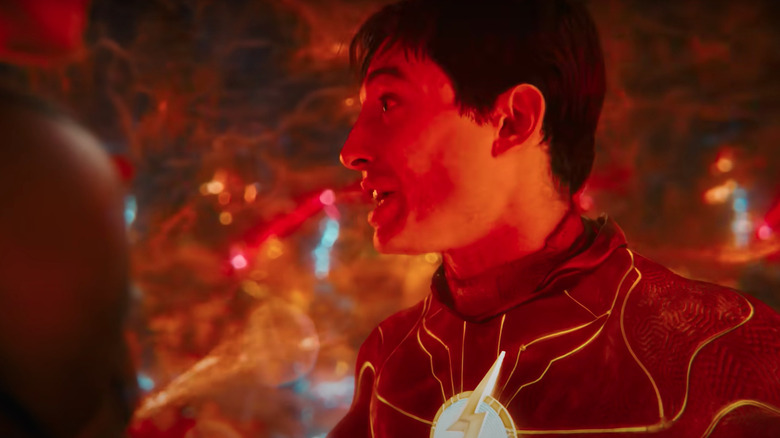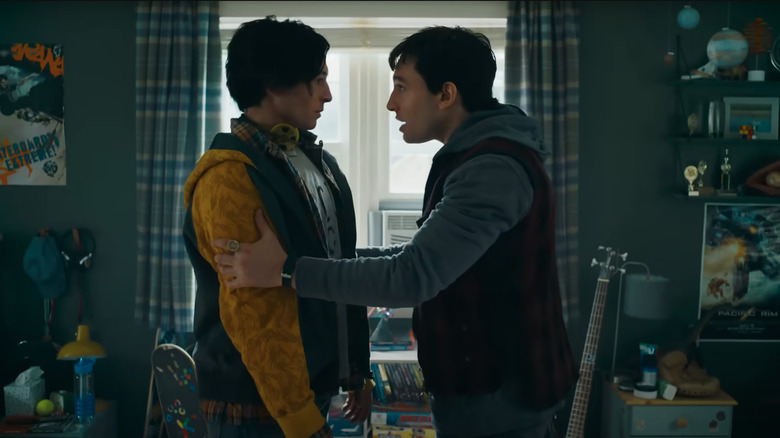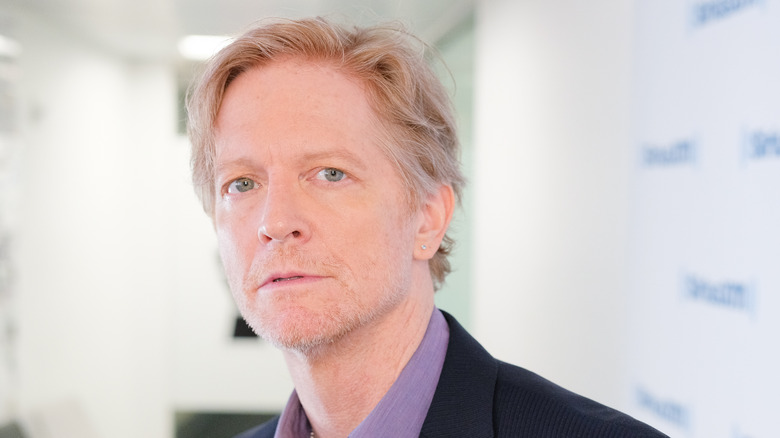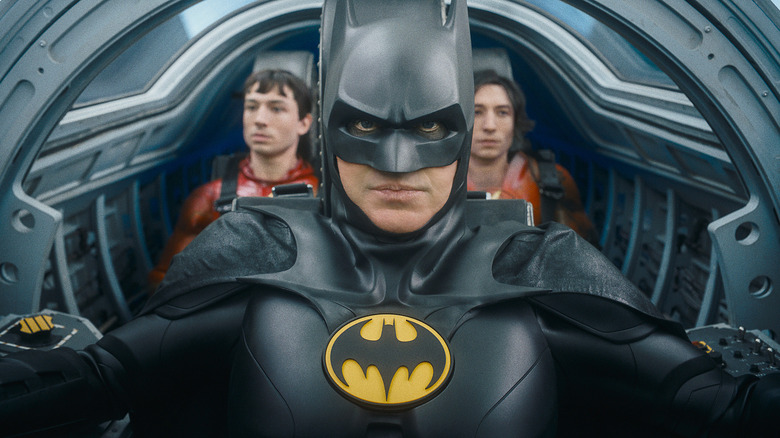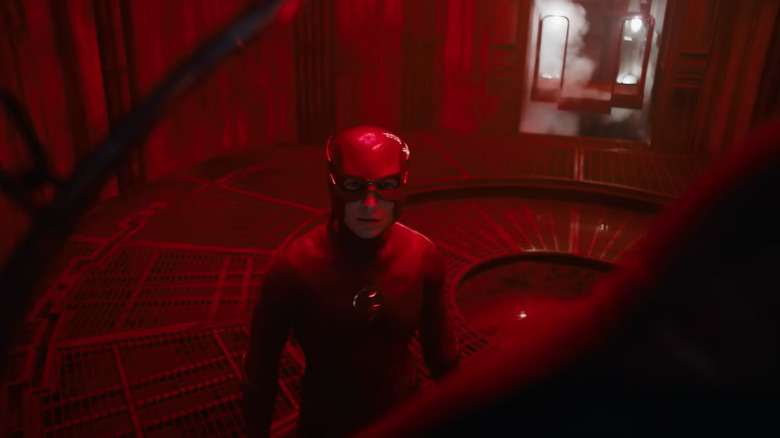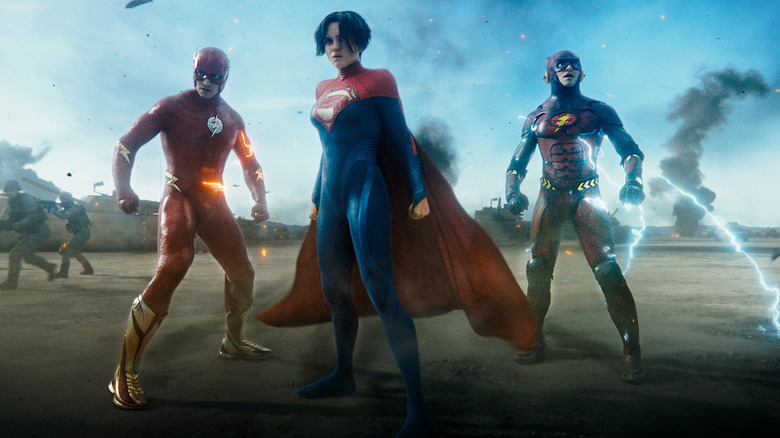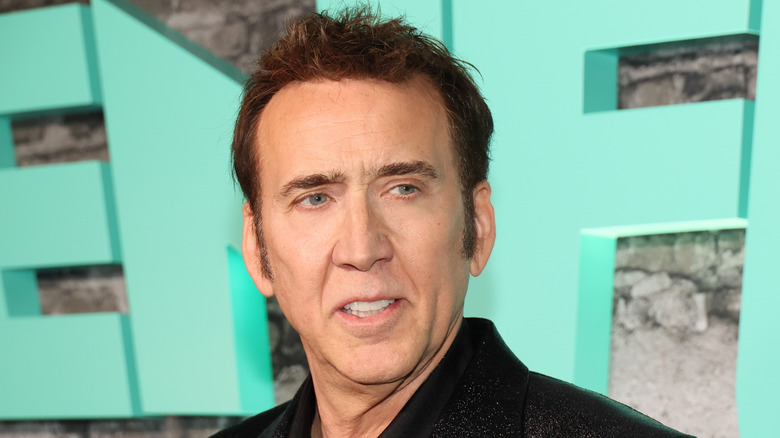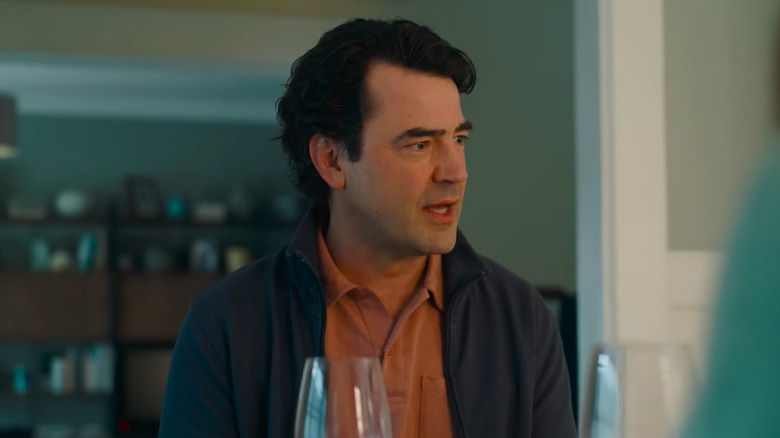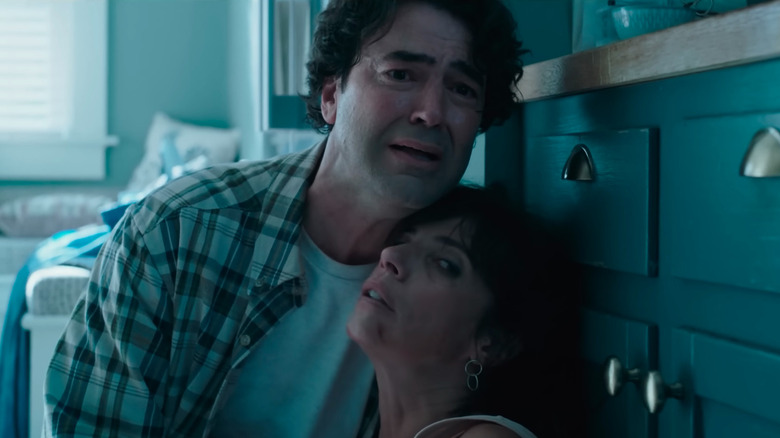Things Only Adults Notice In The Flash
Contains spoilers for "The Flash"
Superman and Batman may have more street cred, but currently, the Flash is having a moment. He has been a force in pop culture for years now, with the CW airing a version of the character (played by Grant Gustin) in the show "The Flash," but Barry Allen is about to reach the next level. The standalone movie, "The Flash," has come out, and although it includes many other superheroes, the Flash (Ezra Miller) is the star of the show.
In "The Flash," Barry decides to try to change the past. While his mother (Mirabel Verdu) died and his father (Ron Livingston) was blamed for it in his timeline, he learns he can go back in time and fix things by preventing his mother's death — only this decision has massive consequences for Barry and the world at large. Although Barry gets his mother back, the world hangs in the balance as Zod (Michael Shannon), the man who challenged Superman (Henry Cavill) in "Man of Steel," is back and Superman is nowhere to be found. This leaves Barry from 2023 to work with Barry from 2013, Batman (Michael Keaton), and Supergirl (Sasha Calle) in an effort to try to stop Zod. And while the movie has plenty of callbacks and callouts, there are several things that may fly over kids' heads. Here are 11 things only adults notice in "The Flash."
Batman makes a good point about being a superhero when the lasso of truth is around him
In the first major action sequence of the film, the Flash rescues a bunch of babies, a dog, and a woman from a collapsing hospital, at Batman's (Ben Affleck) behest. So what's Batman doing? Well, he's trying to capture the people that caused the hospital to collapse in the first place. That's because not only have they caused major destruction, but they've also taken a virus that could be a threat to the entire world. Batman almost has the guy with the virus canisters (Luke Brandon Field) when he falls off a bridge, and Batman goes plunging after him.
That's when Wonder Woman (Gal Gadot) appears and rescues both men with her lasso of truth. While the lasso does the job, it has a side effect: Bruce starts spilling his guts. He notes that he doesn't say thank you because his ego's too big and he also mentions that he knows if he really wants to help he should donate his wealth to social causes, making the whole world better, instead of beating up bad guys one by one and spending his substantial fortune on gadgets to make his crime-fighting easier. It's a funny sequence, especially when Barry touches the lasso and mentions that he knows sex exists but has never experienced it himself. But Bruce is also right: While children may not realize it, donating his wealth would definitely help more people than taking out a villain here and there. He wouldn't get the glory that way, but then again, he wouldn't have the stress either.
Barry works as a forensic scientist
Many superheroes have day jobs. Superman is a reporter, Wonder Woman is an art curator, and Bruce Wayne is CEO of Wayne Enterprises. So it's no surprise that the Flash has a day job too. Early in "The Flash," you can see him working somewhere, but it's not entirely clear what he's doing. That's because his boss makes more of a point of asking him to get coffee than anything involving work.
But Barry is actually a forensic scientist, something you can pick up on by his protests that he needs more time to go over the evidence. This is said in such a subtle way though, that most kids won't notice. So unless children have watched "The Flash" TV series, where Barry was regularly shown in his forensic lab, kids may not realize that's his job in the movie too. This is also because Barry spends so little time at work: While he goes to the lab at the beginning of the film, he doesn't go back, making it hard for his chosen profession to make a big impression.
When Barry runs in place with past events floating around him, he is in the chronobowl
Everyone who takes on a Flash property must figure out how to depict the Flash's relationship to speed. This was hard when special effects were in their infancy, but now filmmakers can do anything and everything to rise to the challenge. It lets people take a lot of big swings, and "The Flash" director Andy Muschietti's biggest swing may be the chronobowl. The chronobowl is essentially Barry's mind palace. In it, he can see his memories, move backward or forwards in time, and seek out specific instances where he's been before in order to change them. Barry is able to access all this through his relationship with the speed force.
Unfortunately, the way it's portrayed is odd. Barry continues to run, but now he runs in place. As he runs, his memories circulate all around him from the most recent to, theoretically, the furthest back. Barry can stop at different points if he wants to change things, and that's how he saves his mother from the knife attack that killed her. But children may not understand all this. After all, it isn't the most dynamic or effective way to show the Flash's memories.
The posters in Barry's rooms are supposed to show the time frame
When the older Barry meets up with the younger Barry, his room in his parents' house and his college apartment are supposed to represent a different kind of Barry. While the older Barry lost his parents and, therefore, has very little on his walls — having grown up without his mother and with his father in jail for her murder — his younger counterpart still has his parents, and consequently has plenty of room decoration to suggest a more stable childhood. But children might miss that posters for films like "Pacific Rim" and "V for Vendetta" don't just give an impression of what kind of boy the young Barry is — it's also reflecting the time period in which the movie is taking place.
The movie establishes that it's 2013 and young Barry is 18. That means that he hasn't experienced the last 10 years of movies. So while his choices in room decor help establish his personality, they also remind audiences that the younger Barry is from an earlier time period than the older Barry.
Eric Stoltz is in Back to the Future in the alternate world
One of the most noticeable hints that Barry is in the wrong universe in "The Flash" comes when the younger Barry and his friends cite Eric Stoltz as the star of "Back to the Future." Yes, in this universe, the star of "Mask" is the lead in the classic '80s time travel film. The thing that many kids may not know is that Stoltz was practically the lead in "Back to the Future" in our world too — if they even know who Stoltz is at all.
Robert Zemekis and his crew had been shooting "Back to the Future" with Stoltz for over a month before Michael J. Fox took over. Stoltz got the part at the urging of Sid Sheinberg, a Universal Pictures exec, after Zemeckis and his producer's choice, Fox, had to drop out of the running due to scheduling conflicts. Yet while Stoltz was a good actor, he had one key issue: He wasn't funny. So they fired Stoltz and ended up using Fox in the 1985 movie anyway. Fox was better suited for the role and he's rightfully remembered for it. The question is, what was the movie like with Stoltz in it? Only Barry and his friends from the alternate timeline truly know.
Batman uses a flip phone
Batman has a ton of high-tech gear. His suits, car, and plane are cutting-edge. However, his phone could use an upgrade. When he and the two Barrys go to the Russian gulag to break out the Kryptonian that's housed there, he uses a flip phone to hack into the cell where they're holding her, and it doesn't go unnoticed by Barry, who comments on the use of such an ancient device. While the device may be ancient by our standards, it was even old by 2013 standards. The first iPhone came out in 2007 — this was six years later.
So why is Batman using such an outdated device? It could be that no one has smartphones in this alternate universe in 2013. But judging by Barry's comment, Batman is just an old guy who's set in his ways, one of which is using a flip phone — after all, he was retired before the Barrys called him back into service. Either way, some of the kids in the audience may be too young to remember flip phones and therefore wonder what Batman's using to break into the prison cell.
Barry refers to the cell holding Supergirl as the 'Big Scrotum'
There are many ways that you could refer to the prison cell holding Supergirl. The "large oval," the "big cell," and even the "place where they're holding the Kryptonian" would do. But Barry has always been colorful, so the younger version of him goes for something a little more ... unique: the "big scrotum." While adults will understand what he's saying right away, kids may have a harder time, because the scrotum is a less discussed part of the male anatomy.
Not only that, but the "big scrotum" is made of materials that don't exactly scream "male anatomy." The brick and chrome that the cell is made of make it look like an impenetrable fortress, so while calling it the "big scrotum" takes some of the seriousness out of it, Batman and the Barrys still have their work cut out for them. Still, young Barry gets points for creativity.
Old Barry's suit disperses the lightning he generates but young Barry's doesn't
The super-suit that the more experienced Barry wears is state of the art. It makes him faster, hides his identity, and most importantly, it dissipates the electricity he generates from being that fast. The younger Barry, however, created his suit in an afternoon, and it has far fewer features. Especially lacking is the power to disperse the lightning he creates when he runs. While the older Barry points this out, there's so much going on at the time — after all, Zod and his cronies are trying to take over the planet — that kids may have missed the comment.
Also while, in theory, the younger Barry will have to take breaks to dissipate the lightning he's generating, in practice, he doesn't take many. This quickly undercuts what the older Barry is saying. In fact, the biggest hint that younger Barry isn't letting go of the electricity he's generating is the way that objects seem to attach to his arms. But because this isn't obviously the result of the electricity, the reasons for young Barry's troubles aren't as obvious as they could be.
Nicolas Cage is Superman in one world, and he almost was in ours
Nicolas Cage has been a star for years, acting in everything from "Raising Arizona" and "Moonstruck" to "The Rock" and "Adaptation." He even won an Academy Award for "Leaving Las Vegas." While his filmography has taken some hits over the years, many people still admire him as an actor. So it makes sense that he shows up as the Superman of an alternate dimension in "The Flash." Kids who recognize the actor will accept the cameo for this reason alone, but what they may not know is that Cage has another reason for being there.
Cage is a massive Superman fan. In fact, he loves Superman so much that he named one of his kids Kal-El, Superman's Kryptonian name. And he was almost Superman in his own movie before it fell apart. While that movie never happened in our universe, in an alternate universe it could have, and that appears to be the argument being made in "The Flash." In Cage's Superman cameo, he fights a giant spider, and that's exactly what was supposed to happen in his canceled "Superman" movie. The movie may never have been filmed but Cage has a blast going through the motions in the cameo. Could this lead to his being resurrected as Superman in our world again? Only time will tell.
Barry gets his father to look up by putting the tomatoes on the top shelf
Barry has been through a lot in his life. Not only was his mother killed when he was a boy, but his father was convicted of her murder, setting him up for a string of appeals to try to get out of prison. Barry knows his father is innocent, even if the justice system doesn't, and stands by him no matter what. It's a long and grueling process of searching for leads that exonerate his father, and Barry thinks he's finally caught a break when Bruce uses new software to unscramble the footage of his father at the grocery store, where he was buying a can of tomatoes at the time of the murder. Unfortunately, his father never looks up, making it impossible to prove it was him.
At the end of the film when he returns to 2023, though, they show this footage in court, and Barry's father now looks up. It's a triumphant moment that frees his dad, but children may be wondering how it happened. When Barry went back to take away the tomatoes in his mom's cart at the grocery store, he also rearranged the shelf of tomato cans so that the one his father needed was at the top of the shelf. With that simple switch, his father's face was now caught on camera. It's an easy change, and it means that his father is coming home from prison.
Barry's dad in The Flash isn't the same man as in Justice League
Henry Allen's story is integral to the Flash. That's because while Barry Allen became the Flash, his reason for wanting to help families in crisis stemmed from his experience with his own family, and especially his experience trying to help his wrongly accused father. In "Justice League," his father is proud of Barry getting a real job at a crime lab, and in "The Flash," his father is exonerated for the killing of Barry's mother, but what kids may not notice is that the two men are not the same.
In "Justice League," Billy Crudup plays Barry's dad, but in "The Flash," Ron Livingston is the one playing Henry Allen. This change came about because of Billy Crudup's schedule: He had a conflict with Apple TV+'s The Morning Show, and therefore, couldn't appear in "The Flash." This opened the door for Ron Livingston, who provided a new interpretation of the character. The two actors both work well as Barry's father, although Livingston has more to do because the movie he's in revolves around the Flash. Still, both men manage to do a good job as Barry's tragic father — even if Livingston's version of the character is the one who manages to get out of prison.
